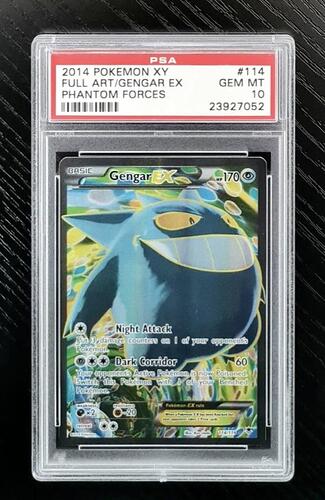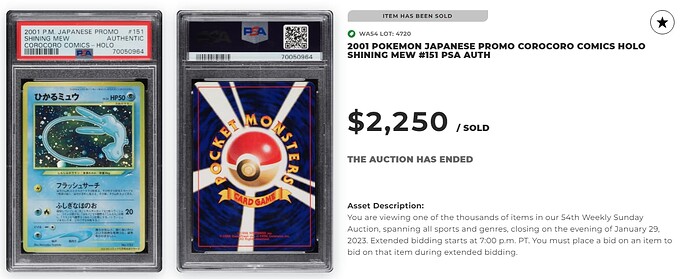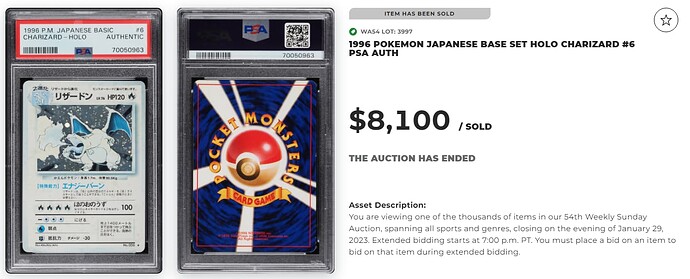Sorry to hear that… ![]()
I disagree. The “authentic” label is just verifying that the card is authentic, which it is. There is nothing misleading about the listing. If a sun faded card is submitted for grading then PSA (along with BGS and CGC) mark it down as damaged in the same way they would for any other kind of damage. It would essentially be the same as saying a card with scratches, edge whitening etc should have a different designation on an authentic label which… kind of defeats the whole point of “authentic” not being a condition assessment.
I agree with petiparty that it would be different in the case of something like a heavily sun-faded PSA 10 that was likely damaged after grading, but even then it’s still really up to the buyer to pay for what they can see on a listing.
I agree that the buyer should be knowledgeable before making a purchase.
The problem with this specific case is that sun-damaged cards look very similar to legitimate errors. Take a look at the “Missing Print Layer/Layers” subsection on CGC’s error guide.
They state:
A missing print layer occurs when a sheet of cards passes through the printer without receiving all four of the CMYKK colors it should. This can occur if ink isn’t properly loaded into the printer or if the printer has a technical fault partially through printing a sheet.
When these sheets are not scrapped as they should be, errors can make it into packs. The two cards pictured above are missing the yellow ink layer and red and yellow ink layers, respectively. Sun-faded cards can appear very similar to the example missing yellow and red ink layers. However, under UV light, sun damaged cards have lost all of their normal UV properties whereas the UV reactions are completely normal on errors like this one.
The Authentic grade is fine in most cases, and I generally do not have a problem with it. When the Authentic grade can be misconstrued as an “Authentic Error,” it concerns me. If these cards received a conditional grade from PSA, they would be PSA 6 at best. That grade would better reflect the damage that the card incurred.
I don’t think that we’re going to agree on this one, and that is okay. I definitely see your perspective and acknowledge that a “hands-off” mentality to these things is probably best. I’m just hoping that we don’t see an influx of slimy submitters trying to sell these (damaged cards) as errors.
I think you’re inferring a lot here. No one is necessarily trying to “get one over” just by selling the cards. PSA has not labeled the cards as errors. There is no “RARE GRAIL” kind of stuff anywhere on the listing. The cards are presented exactly as what they are, and if a buyer decides to think that they’re something different than what’s shown, that’s on them.
I think an even more common case of buyer confusion is in the signature market with misconstruing the authentication and grading between the card and the signature, but the onus is on the buyer to understand what they’re buying before placing a bid.
I feel differently about ebay listings that are explicitly designed to mislead a buyer, but I really don’t see how PWCC is responsible for explaining a PSA label to buyers in this case. In the PSA grading standards it is stated in no uncertain terms:
Yes, this is an assumption. We will have to wait and see.
PSA does not label missing print layer errors at all.
Sure, that’s fine. I like to reduce the possibility of getting upset buyers by being as clear as possible. It is not on PWCC or PSA to state this, but if they did, it would certainly clear up some misconceptions and reduce the possibility of returns/non-payments/angry customers.
Which is my main point. If you’re asking PWCC to explain something that is not on the listing, then where’s the line? What is it about this case in particular that stands out as something special that warrants an extra explanation?
I’m not sure if this is rhetorical or not, so I’ll go ahead and provide the answer.
This specific case can look identical to a highly collectible error, regardless of whether the card is encased by PSA, CGC, BGS, etc. grading. You and I may know that it is damage caused by UV light, but many collectors may not.
The word “Authentic” suggests that the card is real. In my opinion, it really should be “Authentic-Altered.” While that designation is typically reserved for cases of adding color, cutting corners, etc., it serves a purpose here. The card’s color was altered with UV radiation. I don’t see why changing a card’s color with UV radiation is any different from adding a blue sharpie to a whitened border.
To me, they are both “Authentic-Altered.”
Okay, so you personally disagree with PSA’s grading/labeling standards. You’re welcome to your opinion (and even to bring it up with PSA if you’d like), but directly asking a PWCC rep to change listings because of that personal disagreement seems a bit unreasonable and leans into undermining the whole point of a 3rd party authenticator.
PWCC already provides their own assessment of cards’ eye appeal, after they have been authenticated and graded by a 3rd party company. Noting that a card’s colors are not a factory misprint is not that big of a stretch.
We do not offer this service for anything ouside of sports cards, they need to be above a certain price threshold, and above a certain condition. We do not offer eye appeal grades for cards that just look bad.
Yes, I am aware. It was just an example of how PWCC has previously provided their own expert opinion on an authenticated and graded item.
I understand the sentiment. It’s not about the card looking bad, though. It’s about the very real fact that a factory error can look identical to this UV alteration, and that buyers may be uninformed on the difference. I get that PWCC doesn’t want to affect the auction, so no worries.
My best course of action is to speak with PSA to assign an “Altered” condition to UV-damaged cards.
The onus really is on PSA, they already have the qualifier system - this would fit in perfectly
I left an email and voicemail with their lead customer relations specialist. Let’s hope that this works out and that they respond.
I have always loved the look of a sun-damaged Coro Mew.
Also reminds me of this card I once saw:
I assume the sun damage happened after encapsulation?
I agree that the sun-damaged Shining Mew looks super cool.
That Gengar EX was likely sun-damaged after encapsulation. I believe that their automatic deduction for UV-damage is PSA 6 at best.
Small update:
I was able to speak with a Customer Relations Specialist at PSA over the phone. She will be following up with their grading team to look into the problem. We will see what comes of this. Fingers crossed. ![]()
These auction prices are unbelievable… For comparison, a PSA 10 Corocoro Shining Mew is ~$2,500 and a PSA 10 Japanese Base Charizard is ~$4,000.
Japanese Corocoro Shining Mew (sun-damaged) sold for: $2,250
Japanese Base Charizard (sun-damaged) sold for: $8,100
Please send me your cards and I will gladly put them out in the sun for the low price of $500.
puts all slabs in the sun
But seriously, I’m wondering what the buyer(s) were thinking here. Like the zard, there was at least one other bidder willing to pay like $8000 for it.
Memes, stupid wealth, or believing that they were genuine errors.


